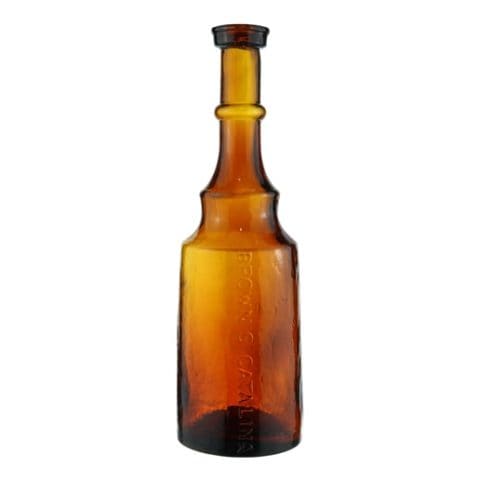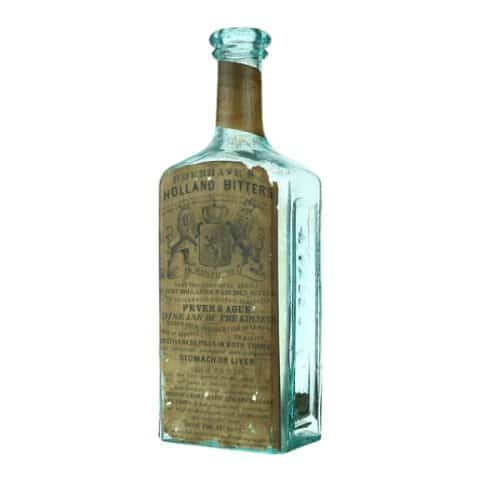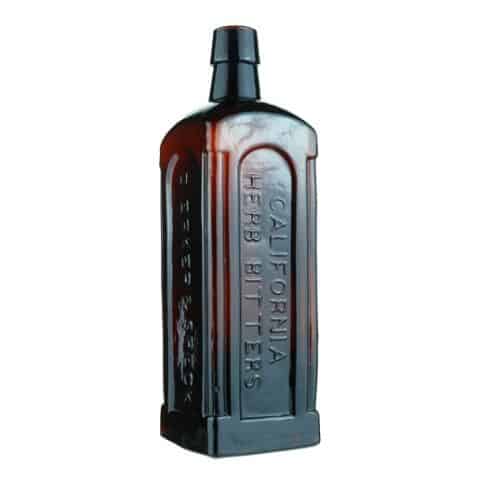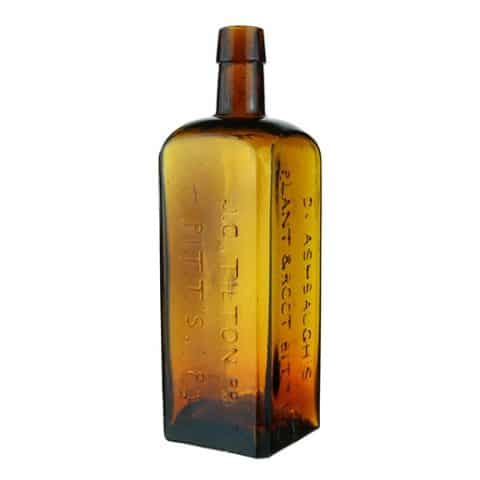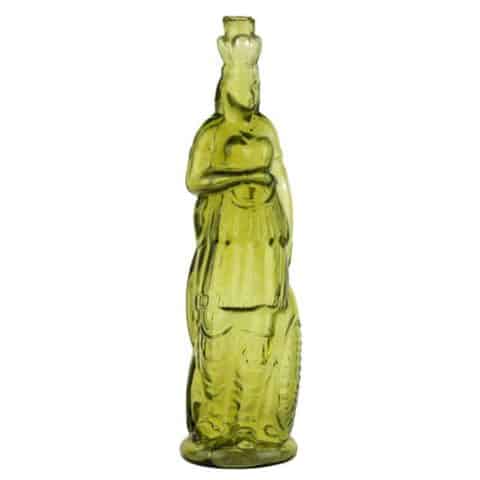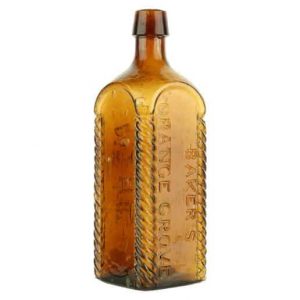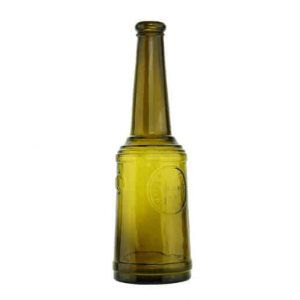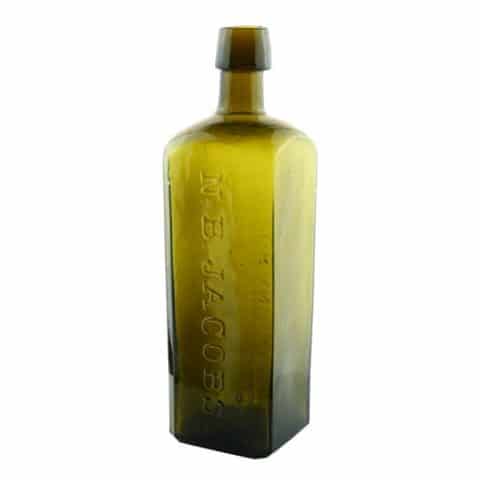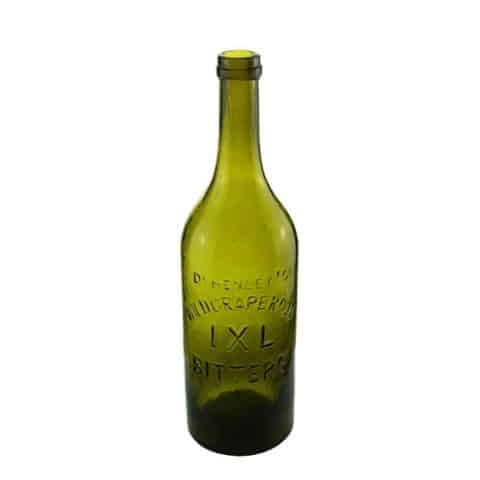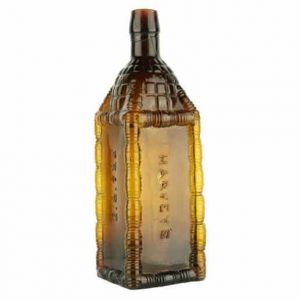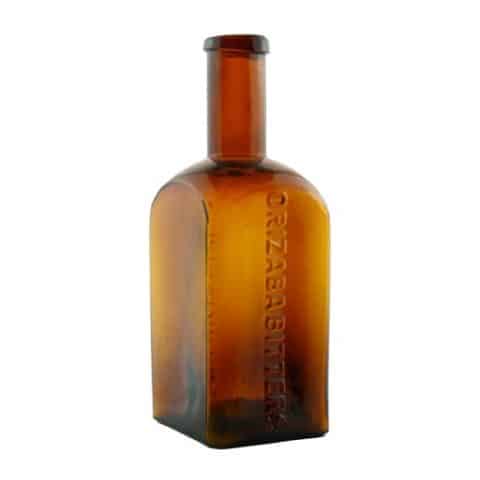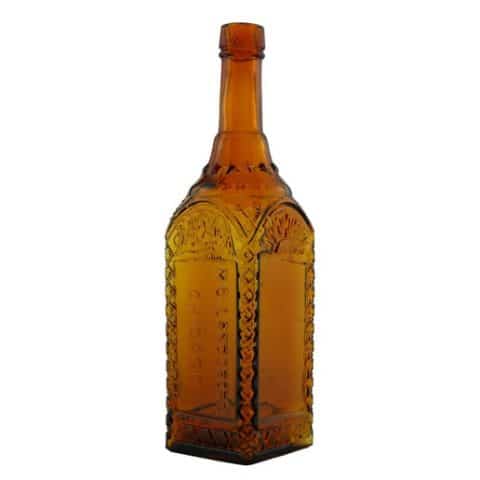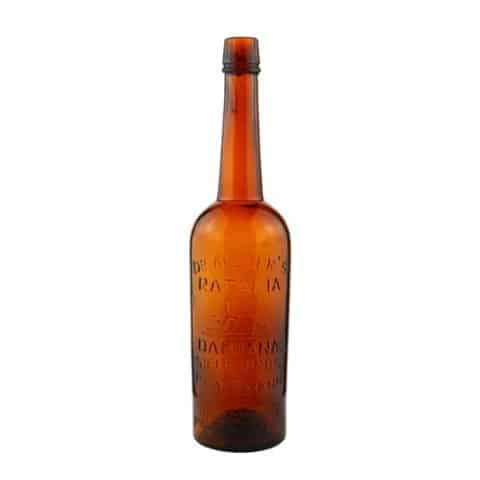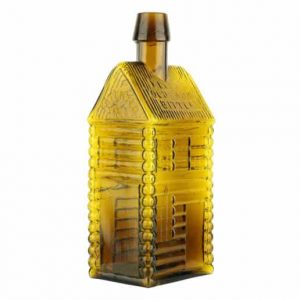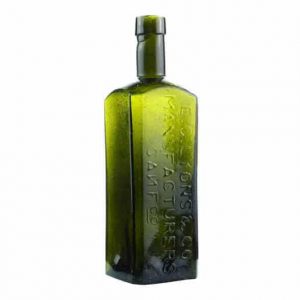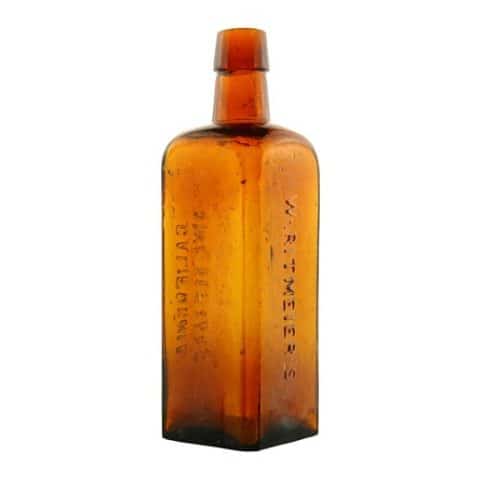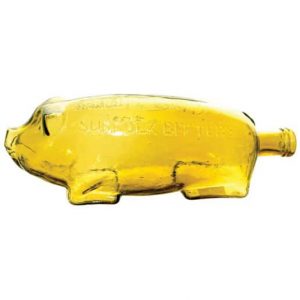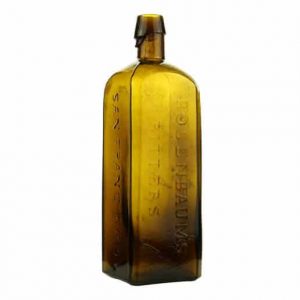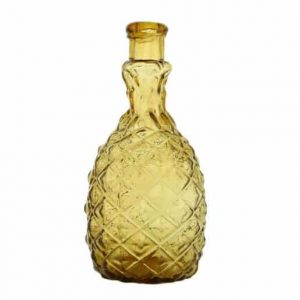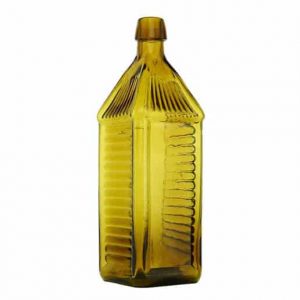Brown’s Catalina
Brown’s Catalina
Brown’s Catalina Wine Tonic
El Vino Catalina
Jerome B. Brown & Co., Baltimore, Maryland
Amber Figural Spanish Cannon-Barrel Form
Provenance: Jerry Forbes Collection

This intriguing figural bottle, embossed “Brown’s Catalina,” was most likely modeled after a Spanish cannon barrel form, though others say it resembles a lighthouse. Collectors classify the bottle as a “Bitters,” however, the Baltimore proprietors, Jerome B. Brown & Co., went to great lengths to differentiate their product by calling it “Brown’s Catalina Wine Tonic” or “El Vino Catalina.” They said it contained all the great benefits of the Catalina grape of sunny Spanish Dominions with calisaya and the spices of Ceylon, and it should not be mistaken as a common whiskey and bitters product using field herbs. Brown’s Catalina Tonic was probably influenced liberally by an island rum, but they concealed that ingredient.

In 1871, announcements were made in many city and town newspapers in the United States reporting that importations had again commenced of the El Vino Catalina or Brown’s Wine Tonic. Advertising further stated that El Vino Catalina was imported initially in 1866 and that the noted “Bitters, long celebrated for its medical qualities,” had stopped because of the high duty demanded by the government. Apparently, the wine tonic had been used with great success in the tropics, Europe, South America, Mexico, and throughout the United States.
Following the path and outlandish claims by most Bitters of this time, the proprietors said that Brown’s Catalina would cure just about anything under the sun. “El Vino Catalina is invaluable in weakness and debility. It relieves morning languor and gives freshness to both mind and body. It sharpens the appetite and is not followed by any unpleasant reaction so common to whiskey bitters. It cures Dyspepsia, Indigestion, Costiveness, Bilious Derangement, Colic, Cramps, Flatulence, Diarrhea, Dysentery, Nausea, Morning Sickness, Anemia, Heart Disease, Nervous Irritability, Liver Complaints, for which it is used throughout all hot climates with great success. Diseases of the Kidney and Bladder, Skin Diseases, all Eruptions, either caused by diseases or by the impurity of the blood. Despondency, Rheumatism, Gout, Gravel, and Whooping Cough, for which it is famous as a Tonic in Consumption, it has no superior, as thousands believe themselves cured by it, yet we do not claim that it will cure Consumption, but if used freely in time we are sure it will prevent it. It is so agreeable to the stomach of the weak and delicate. Elegant for the Colicky and Crying Children.” It is surprising that new advertising stopped in 1872 for such an “amazing” product. El Vino Catalina sold for $10 a case which contained 12 bottles. The brand was sold by druggists, grocers and country stores.
The scarce, 11-inch tall by 3-inch diameter cylindrical bottle can be found in various shades of amber glass and was made by an unknown glasshouse. There is an applied double collar mouth and smooth base. The serif lettering reads vertically shoulder to base “BROWN’S CATALINA.” A rare labeled example reads, “Brown’s Catalina Wine Tonic or El Vino Catalina.” A variant is similarly embossed “BROWN’S CATALINA” with “PTD SEP 17 72.” Jerome B. Brown filed a patent 6,142 for this bottle on September 17, 1872, which matches the date on the embossed variant. The bottle is similar in shape to Brown’s Castilian Bitters, Castilian Bitters and Globe Bitters. We have also included Brown’s Catalina example that may have been blown at a Stoddard, New Hampshire, glasshouse.
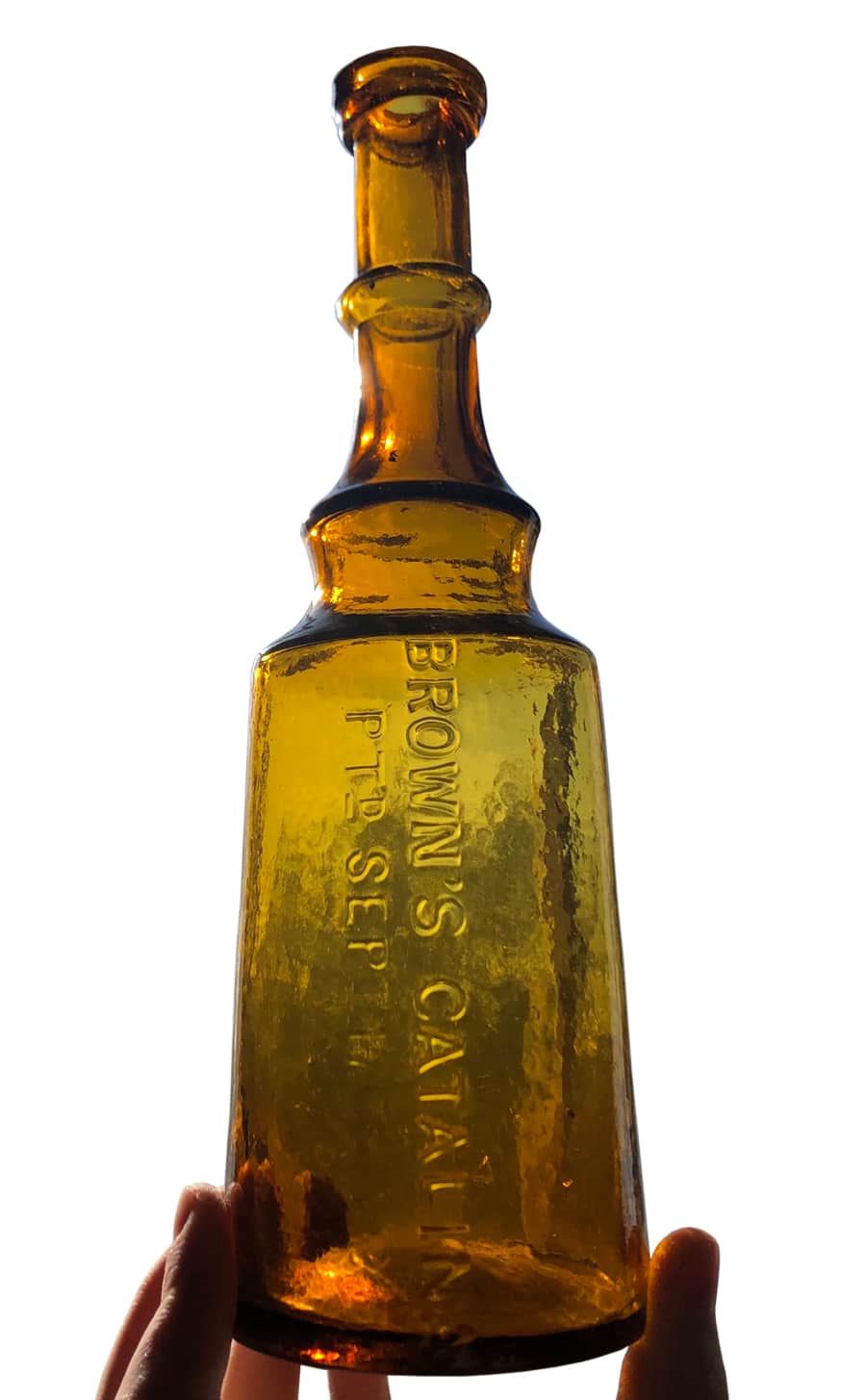
In 1871, Jerome B. Brown & Co., (Jerome B. Brown and Julian Barroll ) were listed as Commission Merchants at 48 S. Howard, which was also referred to locally as Brown’s Catalina Wine Establishment. This is the same Jerome B. Brown who partnered with Patrick H. Drake to manufacture the extremely rare Brown & Drake Catawba Bitters lady’s leg bottle in 1858 when he was in Binghamton, New York. J. M. M. Conrad & Co., located at 19 Light Street in Baltimore, Maryland, were the General Agents for the United States. The last name, “Brown,” is synonymous with many medicines from Baltimore during this period such as Brown Chemical Company.
Primary Image: Brown’s Catalina imaged by Alan DeMaison at the FOHBC Reno 2022 National Antique Bottle Convention mobile imaging station.
Support: Reference to Bitters Bottles Supplement 3 draft by Ring, Ham & Meyer.
Support Image: Auction Lot 15: “Brown’s Catalina” Figural Medicine or Bitters Bottle, probably a Stoddard glasshouse, Stoddard, New Hampshire, 1860-1872. Cylindrical, modified lighthouse form, olive amber, heavy applied square collared mouth – smooth base, ht. 10 7/8 inches. See R/H pg. 120 Beautiful, crude whittled bottle. Kris Kernozicky collection. – Norman Heckler Jr. & Sr., Norman C. Heckler & Company, Auction #103
Support Image: Auction Lot 107: “BROWN’S CATALINA”, (Ring/Ham, pg. 120), American, ca. 1865 – 1875, yellowish amber Spanish cannon form bottle, 11”h, smooth base, applied double collar mouth, an 80% original label in part reads: ‘Brown’s Catalina, Wine Tonic or Vino Catalina, Best Tonic and Invigorator in the World’ etc. About perfect, (a pinhead in size flake is off the outer edge of the lip). I guess at least this bottle dispels the thinking that it contained bitters! Larry Umbreit Collection. – Jim Hagenbuch, Glass Works Auctions, February 2018.
Support: Reference to Brown’s Castilian Bitters – Transitional Cannon Barrel Figural, Peachridge Glass, Ferdinand Meyer V, March 2012
Join the FOHBC: The Virtual Museum is a project of the Federation of Historical Bottle Collectors (FOHBC). To become a member.





